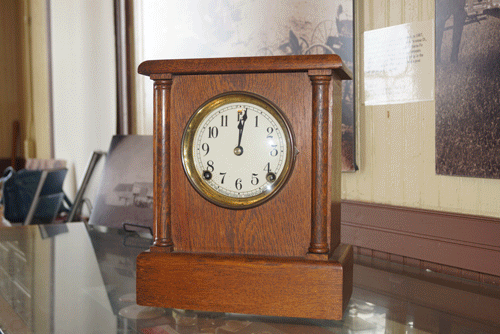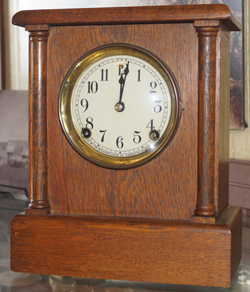Alan and Kim Williams recently visited Garland to donate a piece of the town’s history to the Landmark Museum.
The item was a clock that rested on the desk of Garland’s first woman postmaster, Signora (Nora) Seawright Lemmon, the siblings’ great-grandmother. When she became postmaster, Nora purchased the clock with her own money because the post office would not buy one.
The donated clock later sat on the desk of Nora’s grandson, William J. (Billy) Williams then on her great-grandson’s desk (Alan Williams) after Billy moved into a retirement home.
Kim remembered the clock from the time it spent on her father’s desk, but lost track of it after his move to the retirement home. She thought about it years later and asked her brother if he knew where it was. And he did, as it was sitting on his desk. It was then that they agreed that it belonged in Garland’s Landmark Museum.
Being the first woman postmaster was not Nora’s only impressive accomplishment. She exemplified the true pioneering spirit required for success in difficult times. Her husband, Reynolds McCall Lemmon, was disabled and she bore the responsibility of caring for him and their children. She worked at several jobs through the years, first as a dressmaker, then a telephone operator and postmaster. After retiring from the post office in 1918, she wo
rked in real estate, buying, restoring and selling residential property.
Nora’s grandson (Alan’s and Kim’s father, William J. (Billy) Williams) was born May 5, 1921 on what is now 8th Street, just north of State Street, and it is because of him that his grandmother’s determination and self-sufficiency are documented.
Billy authored a book, “William J. Williams, Some of My Life and Times” in 1991 to describe his earliest years growing up in Garland through late adulthood. According to Kim, he penned the autobiography at the age of 70 thinking that he didn’t have long to live. He was wrong, however, and lived to the age of 92. Kim later published the book and printed copies for all the family members.
The book contains interesting accounts of some of Garland’s most memorable moments in history.
The author described being awakened one night to find that the two-story schoolhouse on 9th Street, where he attended high school, was on fire. He also recalled the 1927 tornado that devastated much of the northern part of Garland and killed numerous residents. At that time, his family lived at 709 Avenue B. In the book, he described how the tornado violently shook the house and the garage was blown off its foundation blocks. The garage remained off the foundation until 1973 when the house was demolished to make way for the construction of the First National Bank.
Billy’s book also brings life to many early residents, like his grandmother, whose lives shaped the community of hard-working people that Garland is today.
To see the clock and a great collection of other historic items and informative exhibits, visit the Landmark Museum at 393 North 6th Street in downtown Garland. The museum is open every Saturday from 10 a.m. – 2 p.m.
Source: “William J. Williams, Some of My Life and Times”


